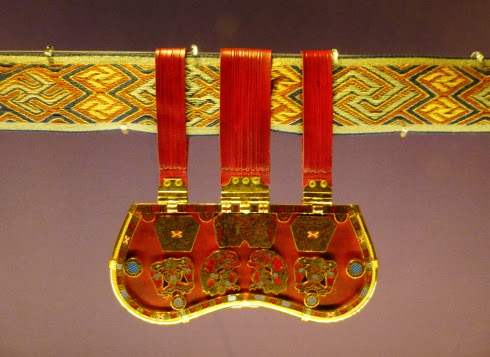 |
| The gold cross found in the grave of the young Anglo-Saxon woman. Photograph: Cambridge University |
The dead are often described as sleeping, but archaeologists in Cambridgeshire have uncovered a bed on which the body of a young Anglo-Saxon woman has lain for more than 1,300 years, a regal gold and garnet cross on her breast.
Three more graves, of two younger women and an older person whose sex has not yet been identified, were found nearby.
Forensic work on the first woman's bones suggests she was about 16, with no obvious explanation for her early death. Although she was almost certainly a Christian, buried with the beautiful cross stitched into place on her gown, she was buried according to ancient pagan tradition with some treasured possessions including an iron knife and a chatelaine, a chain hanging from her belt, and some glass beads which were probably originally in a purse that has rotted away.Pectoral crosses from the dawn of Christianity in England, and bed burials - where the body was laid on a real bed, now traced only by its iron supports, centuries after the timber rotted – are both extremely rare.
 A gold and garnet pectoral cross of such quality, the most beautiful and sophisticated examples of Anglo-Saxon metalwork like the contemporary jewels found in the Staffordshire Hoard or the Sutton Hoo burial, could only have been owned by a member of an aristocratic or even royal family. Only five have been found, one in the coffin of St Cuthbert. In some contemporary pieces the gems came from as far as India, and the gold from melted down coins from Constantinople.
A gold and garnet pectoral cross of such quality, the most beautiful and sophisticated examples of Anglo-Saxon metalwork like the contemporary jewels found in the Staffordshire Hoard or the Sutton Hoo burial, could only have been owned by a member of an aristocratic or even royal family. Only five have been found, one in the coffin of St Cuthbert. In some contemporary pieces the gems came from as far as India, and the gold from melted down coins from Constantinople.


.jpg)






_jpg.jpg)






